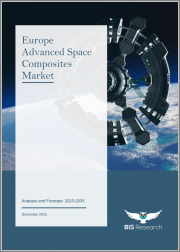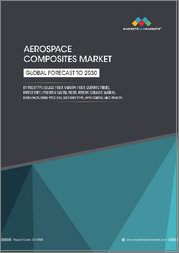
|
시장보고서
상품코드
1396601
유럽의 첨단 우주용 복합재료 시장 분석 및 예측(2023-2033년)Europe Advanced Space Composites Market - Analysis and Forecast, 2023-2033 |
||||||
유럽의 첨단 우주용 복합재료 시장 규모는 2022년 3억 6,000만 달러에서 예측 기간 동안 13.09%의 CAGR을 기록하며 2033년에는 13억 8,000만 달러 규모로 성장할 것으로 예상됩니다.
| 주요 시장 통계 | |
|---|---|
| 예측 기간 | 2023-2033년 |
| 2023년 평가 | 4억 달러 |
| 2033년 예측 | 13억 8,000만 달러 |
| CAGR | 13.09% |
유럽 지역에서는 첨단 우주용 복합재료 시장이 빠르게 중요한 산업으로 성장하고 있습니다. 이러한 성장의 원동력은 우주 탐사 및 위성 기술을 변화시킬 수 있는 견고하고 가벼운 소재에 대한 요구가 증가하고 있기 때문입니다. 복합재료는 기계적, 열적, 구조적으로 우수한 특성을 가진 재료로, 서로 다른 요소를 혼합하여 만들어집니다. 이러한 재료는 우주 시스템의 효율성과 성능을 향상시킬 수 있는 큰 잠재력을 가지고 있습니다.
몇 가지 흥미로운 시장이 우주 기술에서 첨단 복합재료의 독창적인 응용을 뒷받침하고 있습니다. 예를 들어, 인공위성 구조 및 구성요소의 견고하고 가벼운 프레임의 제조는 복합재료에 크게 의존하고 있습니다. 이러한 프레임워크는 발사, 진공 및 고온과 같은 가혹한 요구 사항을 견딜 수 있도록 제작됩니다. 이러한 재료는 더 무거운 페이로드를 탑재하고, 통신 네트워크를 확장하고, 과학 및 지구 관측 능력을 향상시킬 수 있는 더 크고 복잡한 위성을 만드는 데 사용할 수 있습니다.
본 보고서는 유럽의 첨단 우주용 복합재료 시장을 조사했으며, 시장 배경과 개요, 시장 성장에 영향을 미치는 각종 영향요인 분석, R&D·특허 동향, 규제 환경, 사용 사례, 시장 규모 추이 및 예측, 각종 부문별·지역별·주요 국가별 상세 분석, 경쟁 상황, 주요 기업 분석 등의 정보를 정리하여 전해드립니다.
시장 분류
세분화 1 : 플랫폼별
- 인공위성
- 발사 로켓
- 심우주 탐사선 및 로버
세분화 2: 구성요소별
- 페이로드
- 구조물
- 안테나
- 태양전지 패널
- 추진제 탱크
- 우주선 모듈
- 선쉐이드 도어
- 추진기
- 열 보호
세분화 3: 소재별
- 탄소섬유
- 유리섬유
- 열경화성
- 열가소성
- 나노재료
- 세라믹 매트릭스 복합재료(CMC) 및 금속 매트릭스 복합재료(MMC)
- 기타
세분화 4: 제조 공정별
- 자동 섬유 배치(ATL/AFP)
- 압축 성형
- 적층 조형
- 기타
세분화 5: 국가별
- 독일
- 영국
- 프랑스
- 기타
목차
주요 요약
조사 범위
제1장 시장
- 업계 전망
- 첨단 우주 복합재료 시장 : 개요
- 우주용 복합재료에 관한 미래 동향
- 스타트업과 투자 상황
- 주요 복합재료 공급업체와 플랫폼
- 공급망 분석
- 사업 역학
- 사업 촉진요인
- 사업상 과제
- 사업 기회
- 사업 전략
제2장 유럽
- 첨단 우주용 복합재료 시장(지역별)
- 유럽
- 시장
- 용도
- 제품
- 유럽(국가별)
제3장 경쟁 벤치마킹과 기업 개요
- 경쟁 벤치마킹
- 기업 개요
- Airborne
- Beyond Gravity
- CRP Technology S.r.l
- EURO-COMPOSITES
- MT Aerospace AG
- 기타 주요 기업 개요
제4장 조사 방법
ksm 23.12.21“The Europe Advanced Space Composites Market Expected to Reach $1.38 Billion by 2033.”
Introduction to Europe Advanced Space Composites Market
The Europe advanced space composites market is estimated to reach $1.38 billion by 2033 from $0.36 billion in 2022, at a CAGR of 13.09% during the forecast period 2023-2033.
| KEY MARKET STATISTICS | |
|---|---|
| Forecast Period | 2023 - 2033 |
| 2023 Evaluation | $0.40 Billion |
| 2033 Forecast | $1.38 Billion |
| CAGR | 13.09% |
In the Europe region, the market for advanced space composites is quickly becoming a significant industry. The driving force behind this rise is the growing need for robust, lightweight materials that have the potential to transform space exploration and satellite technologies. Composites are materials with better mechanical, thermal, and structural qualities that are created by blending different elements. These materials provide great prospects to improve space systems' effectiveness and performance.
Several interesting market niches support the creative application of sophisticated composites in space technologies. For instance, the production of strong, lightweight frames for satellite structures and components depends heavily on composite materials. These frameworks are made to endure the harsh requirements of launch, vacuum, and high temperatures. These materials can be used to create bigger, more complex satellites that can carry heavier payloads, extend communication networks, and improve scientific and Earth observational capabilities.
Market Introduction
Within the aerospace industry, the Advanced Space Composites Market is rapidly growing and evolving, resulting in the Europe area becoming a prominent and active player on the global scene. Space research, satellite technologies, and many aerospace programs around Europe are being revolutionized by advanced space composites. These materials are designed with outstanding strength-to-weight ratios, remarkable endurance, and versatile applications in mind.
Market Segmentation:
Segmentation 1: by Platform
- Satellites
- Launch Vehicles
- Deep Space Probes and Rovers
Segmentation 2: by Component
- Payloads
- Structures
- Antenna
- Solar Array Panels
- Propellent Tanks
- Spacecraft Module
- Sunshade Door
- Thrusters
- Thermal Protection
Segmentation 3: by Material
- Carbon Fiber
- Glass Fiber
- Thermoset
- Thermoplastic
- Nanomaterials
- Ceramic Matrix Composites (CMC) and Metal Matrix Composites (MMC)
- Others
Segmentation 4: by Manufacturing Process
- Automated Fiber Placement (ATL/AFP)
- Compression Molding
- Additive Manufacturing
- Others
Segmentation 5: by Country
- Germany
- U.K.
- France
- Rest-of-Europe
How can this report add value to an organization?
Product/Innovation Strategy: The product segment helps the reader to understand the different types of solutions available for deployment and their potential in Europe region.
Growth/Marketing Strategy: The Europe advanced space composites market has seen some major development by key players operating in the market, such as partnership, collaboration, and joint venture. The favored strategy for the collaboration between government space agencies and private players is primordially contracting the development and delivery of advanced materials and specialized composite components for space system applications.
Competitive Strategy: Key players in the Europe advanced space composites market have been analyzed and profiled in the study, inclusive of major segmentations and service offerings companies provide in the technology segments, respectively. Moreover, a detailed competitive benchmarking of the players operating in the Europe advanced space composites market has been done to help the reader understand how players stack against each other, presenting a clear market landscape. Additionally, comprehensive competitive strategies such as partnerships, agreements, and collaborations will aid the reader in understanding the revenue pockets in the market.
Methodology: The research methodology design adopted for this specific study includes a mix of data collected from primary and secondary data sources. Both primary resources (key players, market leaders, and in-house experts) and secondary research (a host of paid and unpaid databases), along with analytical tools, are employed to build the predictive and forecast models.
Data and validation have been taken into consideration from both primary sources as well as secondary sources.
Key Market Players and Competition Synopsis
The companies that are profiled have been selected based on inputs gathered from primary experts and analyzing company coverage, product portfolio, and regional presence.
Some of the prominent names in this market are:
|
|
Table of Contents
Executive Summary
Scope of the Study
1. Markets
- 1.1. Industry Outlook
- 1.1.1. Advanced Space Composites Market: Overview
- 1.1.2. Futuristic Trends on Space Composites
- 1.1.2.1. Nanocomposites and Hybrid Materials
- 1.1.2.2. Thermally Resistant Materials for Space Applications
- 1.1.2.3. Self-Healing Composites for Space Applications
- 1.1.2.4. Metal Matrix Composites for Space Applications
- 1.1.2.5. Bio-Composites for Space Applications
- 1.1.3. Startups and Investment Landscape
- 1.1.4. Key Composite Suppliers and Platforms
- 1.1.5. Supply Chain Analysis
- 1.2. Business Dynamics
- 1.2.1. Business Drivers
- 1.2.1.1. Growing Satellite Launches and Deep Space Activity
- 1.2.1.2. Development of Reusable Launch Systems (Orbital and Suborbital)
- 1.2.2. Business Challenges
- 1.2.2.1. High Cost Associated with Space Composites
- 1.2.3. Business Opportunities
- 1.2.3.1. Advancements in Additive Manufacturing of Composites for Space Applications
- 1.2.3.2. Use of Composites in In-Space Transportation Systems
- 1.2.4. Business Strategies
- 1.2.4.1. Partnerships, Collaborations, Agreements, and Contracts
- 1.2.4.2. Others
- 1.2.1. Business Drivers
2. Europe
- 2.1. Advanced Space Composites Market (by Region)
- 2.2. Europe
- 2.2.1. Market
- 2.2.1.1. Key Players in Europe
- 2.2.1.2. Business Drivers
- 2.2.1.3. Business Challenges
- 2.2.2. Application
- 2.2.2.1. Europe Advanced Space Composites Market (by Platform)
- 2.2.2.2. Europe Advanced Space Composites Market (by Component)
- 2.2.3. Product
- 2.2.3.1. Europe Advanced Space Composites Market (by Material)
- 2.2.3.2. Europe Advanced Space Composites Market (by Manufacturing Process)
- 2.2.4. Europe (by Country)
- 2.2.4.1. U.K.
- 2.2.4.1.1. Market
- 2.2.4.1.1.1. Key Players in U.K.
- 2.2.4.1.2. Application
- 2.2.4.1.2.1. U.K. Advanced Space Composites Market (by Platform)
- 2.2.4.1.3. Product
- 2.2.4.1.3.1. U.K. Advanced Space Composites Market (by Material)
- 2.2.4.1.1. Market
- 2.2.4.2. Germany
- 2.2.4.2.1. Market
- 2.2.4.2.1.1. Key Players in Germany
- 2.2.4.2.2. Application
- 2.2.4.2.2.1. Germany Advanced Space Composites Market (by Platform)
- 2.2.4.2.3. Product
- 2.2.4.2.3.1. Germany Advanced Space Composites Market (by Material)
- 2.2.4.2.1. Market
- 2.2.4.3. France
- 2.2.4.3.1. Market
- 2.2.4.3.1.1. Key Players in France
- 2.2.4.3.2. Application
- 2.2.4.3.2.1. France Advanced Space Composites Market (by Platform)
- 2.2.4.3.3. Product
- 2.2.4.3.3.1. France Advanced Space Composites Market (by Material)
- 2.2.4.3.1. Market
- 2.2.4.4. Rest-of-Europe
- 2.2.4.4.1. Application
- 2.2.4.4.1.1. Rest-of-Europe Advanced Space Composites Market (by Platform)
- 2.2.4.4.2. Product
- 2.2.4.4.2.1. Rest-of-Europe Advanced Space Composites Market (by Material)
- 2.2.4.4.1. Application
- 2.2.4.1. U.K.
- 2.2.1. Market
3. Competitive Benchmarking and Company Profiles
- 3.1. Competitive Benchmarking
- 3.2. Company Profiles
- 3.2.1. Airborne
- 3.2.1.1. Company Overview
- 3.2.1.1.1. Role of Airborne in the Advanced Space Composites Market
- 3.2.1.1.2. Customers
- 3.2.1.1.3. Product Portfolio
- 3.2.1.2. Business Strategies
- 3.2.1.2.1. Market Developments
- 3.2.1.3. Corporate Strategies
- 3.2.1.3.1. Partnerships, Collaborations, Agreements, and Contracts
- 3.2.1.4. Analyst View
- 3.2.1.1. Company Overview
- 3.2.2. Beyond Gravity
- 3.2.2.1. Company Overview
- 3.2.2.1.1. Role of Beyond Gravity in the Advanced Space Composites Market
- 3.2.2.1.2. Customers
- 3.2.2.1.3. Product Portfolio
- 3.2.2.2. Corporate Strategies
- 3.2.2.2.1. Partnerships, Collaborations, Agreements, and Contracts
- 3.2.2.3. Analyst View
- 3.2.2.1. Company Overview
- 3.2.3. CRP Technology S.r.l
- 3.2.3.1. Company Overview
- 3.2.3.1.1. Role of CRP Technology S.r.l in the Advanced Spaces Composites Market
- 3.2.3.1.2. Customers
- 3.2.3.1.3. Product Portfolio
- 3.2.3.2. Business Strategies
- 3.2.3.2.1. Market Developments
- 3.2.3.3. Analyst View
- 3.2.3.1. Company Overview
- 3.2.4. EURO-COMPOSITES
- 3.2.4.1. Company Overview
- 3.2.4.1.1. Role of EURO-COMPOSITES in the Advanced Space Composites Market
- 3.2.4.1.2. Customers
- 3.2.4.1.3. Product Portfolio
- 3.2.4.2. Corporate Strategies
- 3.2.4.2.1. Partnerships, Collaborations, Agreements, and Contracts
- 3.2.4.3. Analyst View
- 3.2.4.1. Company Overview
- 3.2.5. MT Aerospace AG
- 3.2.5.1. Company Overview
- 3.2.5.1.1. Role of MT Aerospace AG in the Advanced Space Composites Market
- 3.2.5.1.2. Customers
- 3.2.5.1.3. Product Portfolio
- 3.2.5.2. Corporate Strategies
- 3.2.5.2.1. Partnerships, Collaborations, Agreements, and Contracts
- 3.2.5.3. Analyst View
- 3.2.5.1. Company Overview
- 3.2.6. Other Key Player Profiles
- 3.2.1. Airborne
4. Research Methodology
- 4.1. Factors for Data Prediction and Modeling



















